
by Trish Adams | Sep 1, 2014 | Fat Loss / Cutting, Intuitive Eating, Nutrition
In part 1 of this series we reviewed the basics of macronutrients and why each one plays an important role in your diet. While it’s important to understand what macronutrients are and how they function in your body, what most of us want to know is how to turn that into practical information we can use in our daily lives.
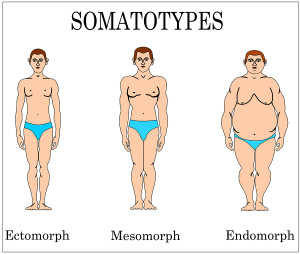 An approach often recommended and used by the EM2WL coaches is eating based on your body type. As with most things related to fitness, every body is unique and finding what works for you and your lifestyle takes some trial and observation. Two people with the same body type may have different diet histories, different external stressors, hormonal imbalances, etc. which may impact results even when eating the same diet. That being said, eating for your body type takes into account metabolic differences based on physical attributes and can guide you with your diet choices.
An approach often recommended and used by the EM2WL coaches is eating based on your body type. As with most things related to fitness, every body is unique and finding what works for you and your lifestyle takes some trial and observation. Two people with the same body type may have different diet histories, different external stressors, hormonal imbalances, etc. which may impact results even when eating the same diet. That being said, eating for your body type takes into account metabolic differences based on physical attributes and can guide you with your diet choices.
A somatotype, or body type as it is most commonly referred to, is a method of categorizing people based on their physique into one of three groups – endomorph, mesomorph, and ectomorph. It is believed that people with similar physiques share other characteristics, such as metabolism, which can inform one’s nutrition. Thus, determining your body type gives you a starting point with your macronutrient breakdown.
Ectomorph

Carbs, carbs, carbs!
Ectomorphs are naturally thin with smaller bone structures. Their metabolic rate is fast and they tolerate carbs well. You may think that having an ectomorph body type is like hitting the physique lottery, but it comes with its own set of challenges including being able to increase muscle mass or put on weight. For that reason, ectomorphs are also known as hard gainers. Because ectomorphs tolerate carbs well, they are prioritize in their diet.
For ectos, a good starting point would be: Carbohydrates 55%, Protein: 25%, Fat: 20%
Ok, I have to admit that having an ectomorph body type is definitely like hitting the food lottery!!
Mesomorph
Mesomorphs have athletic builds (i.e. V shape) with a medium bone structure. They are testosterone and growth hormone dominant which typically translates to more lean mass and lower body fat when active. Mesomorphs are generally able to eat what they want without encountering too many issues. They also aren’t too challenged when it comes to putting on or taking off weight.
Like ectomorphs, carbs are tolerated fairly well and play a starring role in a mesomorph meal plan: Carbohydrates 40%, Protein: 30%, Fat: 30%
Endomorph
Endomorphs have the largest bone structure and tend to carry more body fat as well as muscle mass. They tend to have pear shapes, gain weight easily and are often challenged when trying to lose weight. Endomorphs fair best with more fat and protein in their diet with carb intake kept at a moderate level and arranged around their activity.
pear shapes, gain weight easily and are often challenged when trying to lose weight. Endomorphs fair best with more fat and protein in their diet with carb intake kept at a moderate level and arranged around their activity.
An endomorphs’ intake might look like: Carbohydrates 25%, Protein: 35%, Fat: 40%
Choosing a Body Type Diet
If you’re wondering into which category your body falls or thinking that you could be categorized in more than one category, you’re probably right. Most people do in fact show characteristics of more than one body type.
Trying to fit perfectly into one category is not the goal here. Rather decide which category you feel you fit best in, choose the appropriate macro breakdown and adjust from there.  Undoubtedly many (primarily women) will try to fit into the endomorph category. Even classic ectomorphs will readily identify as an endomorph when trying to lose weight. However, I caution you NOT to immediately assume that your body type is endomorph simply because you are carrying “extra” body fat.
Undoubtedly many (primarily women) will try to fit into the endomorph category. Even classic ectomorphs will readily identify as an endomorph when trying to lose weight. However, I caution you NOT to immediately assume that your body type is endomorph simply because you are carrying “extra” body fat.
To help determine your body type, have a spouse or friend take a picture of you and compare the pic to the body type images (pictures are more objective than mirrors). You might be surprised to find which category you best align with.
Regardless of which category you best identify with, be sure to allow yourself sufficient time to evaluate how your body responds before making ANY changes. Then, once you feel you want to make an adjustment, start small and observe again. Over time you will determine what worked best for you and what didn’t.
Photo credit: Norbert Sobolewski, Egal, Ruthie, DenisNata/bigstockphoto.com

by Trish Adams | Aug 13, 2014 | Nutrition
When embarking on a new fitness goal one of the most challenging components is knowing what to eat, how often and how much. It’s easy to get overwhelmed by the many conflicting recommendations and determining where to begin. A great place to start is simply with understanding the building blocks of nutrition – macronutrients.
Each macronutrient – protein, carbohydrates, fat – is an energy source, however, each plays a different role in our body. Knowing how to balance the macros to better align with your fitness goals will help you make more informed choices when deciding what to eat. Regardless of your fitness goals, in order to keep your body functioning optimally, a balanced diet which includes each of the three macros is needed each day. Here’s a quick overview of each one and how your body uses it.
Protein
 Protein is probably the most highly regarded macro of the fitness-minded for its ability to help rebuild muscle, however, protein provides many other functions within the body. Proteins provide structure to bones, teeth and skin, transports nutrients and other compounds throughout the body and helps maintain fluid and acid balance. Proteins are made up of molecular structures called amino acids. While our bodies can make some amino acids (non-essential), it cannot make other amino acids (essential) and must obtain them from food stuff.
Protein is probably the most highly regarded macro of the fitness-minded for its ability to help rebuild muscle, however, protein provides many other functions within the body. Proteins provide structure to bones, teeth and skin, transports nutrients and other compounds throughout the body and helps maintain fluid and acid balance. Proteins are made up of molecular structures called amino acids. While our bodies can make some amino acids (non-essential), it cannot make other amino acids (essential) and must obtain them from food stuff.
Following an intense resistance training session, the rate at which protein is made and broken down is elevated for a 24-48 hour period. Eating sufficient protein will aid in the repair of muscle fibers damaged during exercise as well as promote adaptations (think GAINS!)
Protein can be found in many foods including lean meats and seafood such as poultry, beef and fish as well as many dairy products like cheese, yogurt and cottage cheese. For non-meat eaters consider foods such as tofu, hummus, legumes, seeds and nuts. When in a pinch, all types of eaters can benefit from keeping a decent protein powder or protein bar on hand for unexpected delays between meal times.
Carbohydrates
 Surprisingly, many of the same fitness-minded folks who hold protein so high, don’t do the same for carbs. While carbs are often regarded as something that should be avoided, they are actually our body’s first choice for energy. Like protein, carbs play an important role in the everyday functioning of our bodies, including the brain and central nervous system.
Surprisingly, many of the same fitness-minded folks who hold protein so high, don’t do the same for carbs. While carbs are often regarded as something that should be avoided, they are actually our body’s first choice for energy. Like protein, carbs play an important role in the everyday functioning of our bodies, including the brain and central nervous system.
Carbs are the preferred fuel source of the body and are also muscle sparing, meaning that when carbs are not restricted, the body is less likely to turn to other sources for energy. Different carbs are often labeled as good or bad, which can lead to unnecessary food restrictions and even outright fear of consumption. A better way to think of carbs is as simple or fast-digesting or slower-digesting, complex carbs. Neither is good or bad and both have a place in your diet. Slower digesting carbs like vegetables, beans and whole grains provide our bodies with fiber, satiety and help maintain blood sugar and energy levels. These carbs should be prioritized in your diet.
Faster digesting carbs like refined grains such as processed cereals, white pastas, white rice and foods with added sugars are best consumed around your training when your energy stores are low and you want to refuel.
Fats
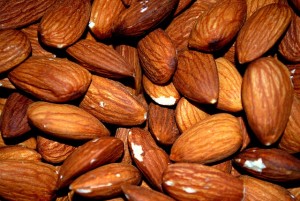 Another macronutrient that has received a bad rap over the years are fats. Fats, like the other macronutrients, are essential to maintaining healthy body function. They provide energy, form cell membranes, aid in the transport of fat-soluble vitamins and help with the manufacture and balance of hormones. Our brains are comprised mostly of fat and as you might have guessed, fat also provides cushioning to our organs. Bottom line, they are needed so don’t avoid them!
Another macronutrient that has received a bad rap over the years are fats. Fats, like the other macronutrients, are essential to maintaining healthy body function. They provide energy, form cell membranes, aid in the transport of fat-soluble vitamins and help with the manufacture and balance of hormones. Our brains are comprised mostly of fat and as you might have guessed, fat also provides cushioning to our organs. Bottom line, they are needed so don’t avoid them!
There are several types of fat from saturated to unsaturated to trans. With the exception of trans fats, which should be avoided, eat a balance of the remaining fats. The easiest way to do that is to eat a variety of fats with an emphasis on omega-3 fats, which are usually in the low end unless you eat a lot of fish or take supplements. In your diet include olive oil, salmon, walnuts, and fish oil.
As you can see, each macronutrient has an important function to the body. Eliminating or severely restricting any can have a negative impact on bodily functions as well as your fitness goals.

by EM2WL | Jul 29, 2014 | Binge Eating, Interviews/Guest Posts, Intuitive Eating, Nutrition

I recently heard dietician/nutritionist, Leslie Schilling, speak at the NSCA National Conference. She instantly wooed me with her Southern drawl, love of food, and “anti-diet” approach (a dietician against diets?! What’s not to love?). Of course, I commenced to immediate stalking, and cornered her for an interview ;) ~Kiki
EM2WL: Your session at the conference “When Diets Don’t Work” focused on Binge Eating Disorder (BED). Can you explain to our readers what BED is?
Leslie: A diet, whether it is the first or fiftieth, could be the trigger to a life-altering or even life-threatening eating disorder. According to the National Eating Disorders Association, these illnesses can affect people of any race, age, sex, or size. Last year, the most common yet under recognized disorder received an official diagnosis code. Now those suffering with BED can no longer be overlooked. BED is associated with the following signs: recurrent binging (once a week for more than 3 months), eating larger than normal amounts of food in a short period of time, and lack of control during the binge episode. According to the Binge Eating Disorder Association, BED may affect 3.5% of women, 2% of men, and as many as 40% of all those seeking weight loss treatments.
EM2WL: Other than lack of purging/excessive exercise, what separates BED from Bulimia and Anorexia?
Leslie: There is no compensatory behavior like over exercising, restricting or “getting rid” of food (purging in any way).
EM2WL: I wonder if it is possible to have this disorder and not know it. A lot of people refer to “cheat meals,” justifying overeating on the weekends after “being good” all week. Does this type of diet mentality have any bearings on developing BED?
Leslie: Yes, it is possible to have BED and not realize it. Dieting over the years, as well as a common culture of “diet-mentality,” may mask an underlying problem. Many of us overeat from time to time, and even eat when we are not hungry. Those with binge eating disorder, however, eat for reasons not always associated with hunger. For example, people suffering from BED may use food to reward themselves, or to escape emotions associated with grief or anxiety, stressful situations, anger, hurtful memories or even past traumas.
My philosophy about “cheat meals” is simple. If what you’re doing requires that you “cheat,” I don’t believe it’s a sustainable or healthy. You could absolutely be eating better than you once did, but perspective matters. I believe in an 80/20 approach which I define as eating whole and low-ingredient foods most of the time and comfortably blending it with pleasurable foods that may or may not have a high nutritional value. Like, I have this thing with cupcakes…
My philosophy about “cheat meals” is simple. If what you’re doing requires that you “cheat,” I don’t believe it’s a sustainable or healthy.
EM2WL: Would you consider an overindulgence, say eating an 2 or 3 servings of a favorite dessert, a binge? How can we distinguish between an overindulgence v a binge?
Leslie: It’s possible I could eat two cupcakes here and there. I likely over-indulged and won’t do that again for a long time. A binge may look like 4, 6, or even a dozen cupcakes but it really depends on the person and the motivation.
Here’s an example—If I eat an extra cupcake because Aunt Betty makes amazing strawberry cupcakes, it may be a simple indulgence. If I’m eating 2, 4, etc.. of Aunt Betty’s cupcakes because my boss said something horrible to me—I’m “using” food and therefore, potentially binging.
EM2WL: The term ’emotional eating’ is used quite a bit with regard to challenges faced when trying to lose weight. Is this just another label for BED?
Leslie: Normal eaters sometimes eat for emotional reasons vs. physiological hunger. However, when you find yourself eating for reasons other than hunger frequently, it’s possible there could be some form of disordered eating going on, like BED.
If someone is over “using” food, it’s possible to teach them the tools to recognize and redirect those behaviors. Once they improve those behaviors, it’s very likely that weight loss becomes a side-effect.
EM2WL: You mentioned that if the shame-based approach worked, that the problem might not be as widespread. How does the media, trainers, friends, or parents contribute to the shame-based approach to fat loss? And how does that play into BED?
Leslie: Many of us who work in the field of disordered eating say “if shame worked, no one would have a weight issue.” Making someone feel bad about themselves is NEVER productive. Our “war” on obesity has become a war against people, real people, like you and me, with real life problems. I like to think you catch more flies with honey. Being caring and non-judgmental opens the door to sustainable change. Here’s one of my favorite quotes.
Nobody really gets anywhere “shouldn’t’” on themselves. When we feel the pressure to change things like our bodies, our diets or exercise routine, it’s important that trainers, dietitians, parents, health professionals, etc… use an approach that moves someone towards making healthy decisions for themselves. I rarely support someone’s goal of “weight loss.” I discuss what’s going on with their food, lack of food, over “use” of food, and help them set goals that promote lasting healthy behaviors. If someone is over “using” food, it’s possible to teach them the tools to recognize and redirect those behaviors. Once they improve those behaviors, it’s very likely that weight loss becomes a side-effect.
EM2WL: If someone suspects they might have BED is there anything they can do on their own to treat the disorder?
Leslie: It’s unlikely, yet not impossible. It’s about the food and NOT about the food at the same time. A successful team usually includes an experienced mental health professional along with an experienced dietitian (one who works with BED/emotional eating).
If you’re wondering if you may need a little help, you can absolutely start by helping yourself. Keeping a food journal (no calories, numbers, etc) to record when you eat, what you eat and how you’re feeling (am I hungry, angry, lonely, tired?). An individual non-judgmental investigation of how you’re using food can provide tremendous insight.
EM2WL: As a dietitian, what do you feel the biggest flaw is in the “eat less, workout more” philosophy?
Leslie: If it were as simple as eat less, work out more, I think most every person on the planet would have mastered the food and weight thing by now. We often assume it’s all about energy in and energy out. It’s not really when you think about all the other factors that influence our body weight & eating—emotions, endocrine issues, body types, dieting history, fitness levels, and so on…
I love giving this example. Say you have a 50 calorie snack and a 150 calorie snack. If you’re simply eating based on a quantity (calorie) approach, it’s very possible you’ll pick the fat-free, sugar-free chemical soufflé. If you eat based on a quality approach, you’re more likely to pick the higher energy choice—almonds—ingredient: almonds.

EM2WL: You have a new dinner menu service launching soon, deets please!! What awesomeness should we expect from Your Supper Solution?
Leslie: I’m incredibly excited about this launch! Earlier this year I’d enrolled in a business development course because I needed direction for my next steps as an entrepreneur. As you know, I’m a registered dietitian/nutritionist but I was stuck. This desire to do something that could positively impact people on a larger scale was really eating at me. I didn’t know if I needed to focus on expanding my private practice, speaking engagements, write a book, or what. The lack of clarity was incredibly frustrating.
As I was doing my homework (which I loved because I’m a total geek), it came to me. I rock planning a menu like nobody’s business and I realized that planning has been a major part of what I’ve been helping people with for the last 10 years.
Many people can cook, follow a recipe and shop but most HATE the planning. So, I’ve created Your Supper Solution—an online monthly membership service that delivers weekly dinner menus. It’s a balanced, back-to-basics, real food approach to getting supper solved! Menus roll out August 1st! Here’s a quick video about it.
EM2WL: Sweet! You know I’m already on the pre-launch list, lol. Where else can our readers read/see/hear more from you?
Instagram: http://instagram.com/leslieschilling
Facebook: https://www.facebook.com/NutritionLeslie
Twitter: https://twitter.com/NutritionLeslie
Pinterest: http://www.pinterest.com/leslieschilling/
Meal Planning Website: www.yoursuppersolution.com
Memphis-based Private Practice Website: www.schillingnutrition.com

Leslie Schilling
Leslie is a master’s level, registered, and licensed dietitian/nutritionist who specializes in wellness, disordered eating, sports nutrition, and the prevention of chronic dieting. She received her Bachelor of Science and Master’s degrees from Appalachian State University in NC. Leslie owns Schilling Nutrition Therapy, LLC, a Memphis-based nutrition counseling practice, and is the creator of Your Supper Solution.
She is a member of Sport, Cardiovascular and Wellness Nutrition (SCAN), Behavioral Health Nutrition (BHN), Nutrition Entrepreneurs (NE) Practice Groups of the Academy of Nutrition and Dietetics (AND), the National Strength & Conditioning Association (NSCA), the Eating Disorders Coalition of Tennessee (EDCT), and The National Speakers Association (NSA).
Leslie has served as an adjunct instructor in the Graduate Nutrition Program at the University of Memphis. She has also been invited to provide her humorous, down-to-Earth nutrition programs and presentations to groups and professionals across the nation. In addition, she writes for local media, professional, and consumer publications. Whether it is through appearing on a television show, speaking to a crowd, or writing, Leslie inspires those she encounters to get back-to-the-basics with food and make self-care a priority through planning.

by | Jul 17, 2014 | Consistency, Fat Loss / Cutting, Nutrition
 Planning ahead can be a critical piece of the puzzle in seeing the results you desire and progressing towards your fitness goals. In the beginning stages, it can feel pretty overwhelming and stressful to get all the pieces in the right place. Don’t let it overwhelm you! “Winging it” is usually a recipe for inconsistency. When life gets busy, it’s second nature to resort back to whatever habits come naturally. The key is to “trick” yourself into building new healthy habits. Coming up with a system that works is going to be a very individualized process, but once you discover what works for you, its easy to include some basic routines that help you remain consistent and on-plan.
Planning ahead can be a critical piece of the puzzle in seeing the results you desire and progressing towards your fitness goals. In the beginning stages, it can feel pretty overwhelming and stressful to get all the pieces in the right place. Don’t let it overwhelm you! “Winging it” is usually a recipe for inconsistency. When life gets busy, it’s second nature to resort back to whatever habits come naturally. The key is to “trick” yourself into building new healthy habits. Coming up with a system that works is going to be a very individualized process, but once you discover what works for you, its easy to include some basic routines that help you remain consistent and on-plan.
1. Be specific about your fitness goals.
Know what you want and what you are expecting out of a lifestyle change. Simply saying that you want to “get in shape,” “be fit,” “look better,” or “feel better” is not enough! Is your main fitness goal to get stronger, improve athletic performance, lose fat, or gain muscle? Start there, but take it a step further by narrowing those goals down a bit more. Maybe you want to run your first 5k, add 20 pounds to your squat, lose 5% body fat, or gain 5 pounds of muscle. Narrowing down those goals will help you determine what type of nutrition and training program you need to stick to. Understand that some goals might be hard to attain at the same time, and usually one goal will need to take priority over another. For example, it can be very difficult to gain strength while losing fat. Decide which goals are your first priority and plan accordingly.
Disclaimer: For the first year or two, pretty much anything you do will get you results, so keep it simple and enjoy those newbie gains while they last.
2. Tackle your nutrition head-on
 It’s been said that success boils down to 80% nutrition, and 20% training. Other people will tell you that you “can’t out-train a bad diet.” It could be argued also that you can’t out-diet bad training, but you get the idea. Nutrition is a critical component, if not THE critical component in seeing the results that you want. If your nutrition is not on point, it is pretty much useless to add in supplements, metabolic conditioning, finishers, or the latest strength training plan that you found on the internet. Contrary to what you may have heard, eating less and moving more is not always the answer. Undereating can cause more harm than good long-term, resulting in metabolic problems that make it more difficult to lose weight. Eating enough of the right nutrients is a big piece of the puzzle. Balancing a sound nutrition plan with heavy resistance training is a surefire way to look and feel your best for years to come!
It’s been said that success boils down to 80% nutrition, and 20% training. Other people will tell you that you “can’t out-train a bad diet.” It could be argued also that you can’t out-diet bad training, but you get the idea. Nutrition is a critical component, if not THE critical component in seeing the results that you want. If your nutrition is not on point, it is pretty much useless to add in supplements, metabolic conditioning, finishers, or the latest strength training plan that you found on the internet. Contrary to what you may have heard, eating less and moving more is not always the answer. Undereating can cause more harm than good long-term, resulting in metabolic problems that make it more difficult to lose weight. Eating enough of the right nutrients is a big piece of the puzzle. Balancing a sound nutrition plan with heavy resistance training is a surefire way to look and feel your best for years to come!
3. Stay one step ahead with meal planning
Given that nutrition is such a key part of the puzzle, it is wise to plan ahead to succeed. Generally “winging it” in the nutrition department leads to inconsistency and frustration. In the beginning stages, it can feel downright stressful to think about eating “all that food”. Don’t get overwhelmed! A little organization and forethought goes a long way in this department.
- Coming up with a few meal templates in your food diary can be incredibly helpful. Choose at least 3 go-to breakfasts, lunches, dinners, and snacks and store them in your nutrition tracker of choice (We’re fond of My Fitness Pal!). Keep it simple, and make sure that you have staples for these meals on hand most of the time. This puts you at a huge advantage when you just can’t imagine adding one more thing to your plate.
- Try to limit your trips to the grocery store to once a week, with maybe a larger trip to a warehouse store (like Costco or Sam’s club). The night before you do your grocery shopping, take inventory of your fridge and cupboards and come up with a loose structure for weekly meals. I like to come up with six meals to serve my family, assuming that one night a week we will either do leftovers, order pizza, or go out to eat. I post these meals on a dry-erase board on the refrigerator and when asking, “What should I make for dinner?,” the choices are pretty simple. After coming up with my list of meals, I make sure I either have the ingredients already or add them to my grocery list.
 Devote one day to food prep. This doesn’t mean you need to spend all day in the kitchen, but do make up some lean protein sources and store them in a way that is convenient for you. Make up some rice, quinoa, or potatoes and chop your veggies and fruits for the week. This will seriously cut down on the amount of time you spend in the kitchen and if you work outside the home can be a huge time-saver when it comes time to pack your lunch. Think about using the grill for preparing your protein sources. You can generally get away with cooking up a lot of meat in a very short amount of time, with minimal clean up. Investing in a rice cooker or a good slow cooker might make these ideas easier as well! I prefer to do my food prep days on the days I do grocery shopping because it seems to make sense for me. I’m usually able to get quite a bit done in only an hour or two, and this saves me a ton of time in the kitchen throughout the week!
Devote one day to food prep. This doesn’t mean you need to spend all day in the kitchen, but do make up some lean protein sources and store them in a way that is convenient for you. Make up some rice, quinoa, or potatoes and chop your veggies and fruits for the week. This will seriously cut down on the amount of time you spend in the kitchen and if you work outside the home can be a huge time-saver when it comes time to pack your lunch. Think about using the grill for preparing your protein sources. You can generally get away with cooking up a lot of meat in a very short amount of time, with minimal clean up. Investing in a rice cooker or a good slow cooker might make these ideas easier as well! I prefer to do my food prep days on the days I do grocery shopping because it seems to make sense for me. I’m usually able to get quite a bit done in only an hour or two, and this saves me a ton of time in the kitchen throughout the week!
4. Make a date with yourself
Once you have your nutrition in place, commit to making time to exercise. This does not mean that you need to spend hours in the gym! 30-60 minutes per day of an efficient workout can be very effective. If you have trouble getting to the gym, think about investing the help of a friend or workout partner who can keep you accountable. You’re unlikely to skip the gym if you know that you have someone depending on you! Write down your workout times in your calendar, or set up alerts on your smart phone to remind yourself to get moving. For best results, strength train 2-4 days per week and add on some cardio if you like it and it complements your fitness goals.
5. Set up your own support network
 Having people in your life who are willing to support your goals can make a huge difference! Enlisting the support of your spouse or significant other is often very beneficial. Even if they don’t have the same set of goals as you do, share what you are trying to accomplish and a brief description of your plan moving forward. Be clear about ways they can support you and examples of things that may be a hindrance to your fitness journey. They are likely to be your biggest cheerleader and encourager! Who knows, they may even decide it wouldn’t hurt them to make a few changes in their own life! Apart from your spouse, you may find there are others in your life that want to join with you on your fitness journey. Maybe there is someone at your workplace who could use a little encouragement and accountability as well. Take your headphones out occasionally while you are at the gym and get to know those who work out at the same time you do. Meet a friend for a weekly HIIT date in the park. Having a training partner to bounce ideas off of can be an invaluable resource, but isn’t always practical.
Having people in your life who are willing to support your goals can make a huge difference! Enlisting the support of your spouse or significant other is often very beneficial. Even if they don’t have the same set of goals as you do, share what you are trying to accomplish and a brief description of your plan moving forward. Be clear about ways they can support you and examples of things that may be a hindrance to your fitness journey. They are likely to be your biggest cheerleader and encourager! Who knows, they may even decide it wouldn’t hurt them to make a few changes in their own life! Apart from your spouse, you may find there are others in your life that want to join with you on your fitness journey. Maybe there is someone at your workplace who could use a little encouragement and accountability as well. Take your headphones out occasionally while you are at the gym and get to know those who work out at the same time you do. Meet a friend for a weekly HIIT date in the park. Having a training partner to bounce ideas off of can be an invaluable resource, but isn’t always practical.
Our EM2WL forums are a great source of support and friendship as well.
Photo credit by Stuart Miles, LeeGillion, Ambro of freedigitalphotos.net
 Becca is a busy wife and homeschooling mother to five children ages 5 to 13. About three years ago, she embarked on a journey to health and fitness that resulted in the loss of approximately 100 pounds. Today, she is a competitive powerlifter and strongwoman who loves ice cream and deadlifts. As an ISSA certified personal trainer, she is passionate about helping women to get started on a lifestyle of strength and fitness.
Becca is a busy wife and homeschooling mother to five children ages 5 to 13. About three years ago, she embarked on a journey to health and fitness that resulted in the loss of approximately 100 pounds. Today, she is a competitive powerlifter and strongwoman who loves ice cream and deadlifts. As an ISSA certified personal trainer, she is passionate about helping women to get started on a lifestyle of strength and fitness.

by EM2WL | Jul 7, 2014 | Consistency, Fat Loss / Cutting, Nutrition, Troubleshooting
 If you listen to the media, fat loss can sound pretty complicated. High carb, low carb, nutrient timing, intermittent fasting, carb cycling, ketogenic diets, carb backloading, juicing, green smoothies, magical supplements…
If you listen to the media, fat loss can sound pretty complicated. High carb, low carb, nutrient timing, intermittent fasting, carb cycling, ketogenic diets, carb backloading, juicing, green smoothies, magical supplements…
It can be challenging to keep a level head and avoid all the latest trends, wondering if a tweak (or two) might be a way to break out of a plateau or to get better results. There are definitely times to include a tweak, but generally speaking, its best that you save these for times that you really need them.
So how do you know if its time to include a tweak?
At EM2WL, we encourage you to take a very no-nonsense, simplified approach to fat loss with minimal rules. Instead of spinning your wheels to figure out which diet is best — take a moment to strip away the “nonsense” from various diet plans that are often just minute variations on the basics. There are a few best practices that we believe to be critical to your success. It’s best to make sure that these elements are firmly in place before tweaking anything.
Think about building a successful fat loss program like building a house. When building a house, you wouldn’t want to try putting up walls before the basic foundation has been laid. Without a firm foundation to build upon, everything else is pretty useless.
What makes up the foundation of a successful fat loss program? We believe there are four key components that are critical to have well established before incorporating any other “tweaks.” We recommend looking over your current fat loss plan and evaluating whether you have a good handle on the following four elements before making any additional changes. How do you measure up?
1. Sufficient calorie intake
 If you’ve been following EM2WL for some time, you know that we firmly believe that eating enough is a key component of a successful fat loss plan. The standard “eat less, exercise more” model of weight loss can lead to more muscle than fat loss, lowering your metabolic rate over the long term. Without eating enough calories, you run the risk of causing metabolic damage which does more harm than good. If you’ve been dieting for a very long time and are not seeing the results that you desire, it is very likely that you would benefit from doing a metabolic reset. If you are still struggling to get in an appropriate number of calories daily, it is highly recommended that you become consistent there before incorporating any additional changes. If you’re curious about how many calories is considered sufficient, check out our calorie calculator.
If you’ve been following EM2WL for some time, you know that we firmly believe that eating enough is a key component of a successful fat loss plan. The standard “eat less, exercise more” model of weight loss can lead to more muscle than fat loss, lowering your metabolic rate over the long term. Without eating enough calories, you run the risk of causing metabolic damage which does more harm than good. If you’ve been dieting for a very long time and are not seeing the results that you desire, it is very likely that you would benefit from doing a metabolic reset. If you are still struggling to get in an appropriate number of calories daily, it is highly recommended that you become consistent there before incorporating any additional changes. If you’re curious about how many calories is considered sufficient, check out our calorie calculator.
2. Protein
Not only do most women typically not take in enough calories, but tend to be lacking in the protein department as well. This macronutrient can be one of your biggest weapons in winning the fat loss game! Generally, we recommend taking in about 0.8 to 1.0 grams of protein per pound of body weight. A number of studies have shown numerous benefits to high-protein diets. Since protein takes longer for the body to break down and digest, it promotes a feeling of fullness, making it easier for you to stick to your plan. Protein also is essential in sustaining your lean mass, helping you to recover from workouts, and maintaining healthy skin, nails and organs. Protein also has been reported to improve brain function, lower blood pressure and improve sleep quantity.
It can be very challenging to get in all that protein! Give yourself time to get acclimated to a higher protein diet by setting reasonable goals and increasing them weekly. For instance, if your goal is to eat 150 grams of protein, but you’re currently averaging around 75 grams daily, you might start by trying to get in just 100 grams daily and increase slowly. Divide your protein among your meals, and it will likely seem a bit more manageable. Focus on making sure to hit your protein target daily, and then allocate the remaining calories to carbohydrates and fats.
3. Fiber
Most Americans only average about 15 grams of fiber daily, while most people should be taking in anywhere from 20 to 30 grams of fiber daily. Foods high in fiber are more filling and generally take longer to eat than foods low in fiber. They are a great way to “stretch out” your meals, thereby eating a high volume of food without adding many calories. In addition, including fiber in your diet will slow the digestion of carbohydrates and absorption of sugars, keeping blood sugar stable. High fiber foods also promote digestive health and prevent problems like constipation, hemorrhoids, IBS, and other digestive complaints. High fiber diets also promote heart health by moving fats and bile salts out of the body, lowering cholesterol in the process.
Tip: Yummy snacks like Quest Bars can provide 20g of protein, and 17g of fiber per serving. They can be helpful to reach your goals in a pinch, or if you’re newer to tracking these macros, but be sure to try getting as much protein and fiber from whole food sources as possible.
4. Heavy Resistance Training
Heavy resistance training should be a key component of any fitness program whose goal is fat loss. Heavy resistance training has a number of metabolic benefits that will pay off in the fat loss department. Unlike cardio, the metabolic benefits of this type of training last for 24-48 hours after completing your workout as your body must work harder to rebuild its oxygen stores. This effect, commonly referred to as the afterburn effect or EPOC (post-exercise oxygen consumption) has a number of metabolic and athletic benefits that will improve your body composition as well as your gym performance! If you don’t know where to start, there are a numb er of strength training programs to get you started on your journey to a leaner, stronger, healthier you!
er of strength training programs to get you started on your journey to a leaner, stronger, healthier you!
If your current fitness program does not currently involve heavy resistance training at least 2-3 times a week, it is highly recommended that you start here before adding in cardio or other forms of exercise to accomplish your goals. You will be amazed at the way your body transforms when you consistently hit the weights!
DISCLAIMER: We know that many of our followers love running and other forms of cardio and we firmly believe that you should regularly engage in a form of exercise that you truly enjoy! However, there may be times to evaluate whether your preferred form of activity supports your goals.
The Take Away Message
If you feel that you have a good handle on these four elements, there is absolutely nothing wrong with making a small change or two to see how your body responds. We emphasize that it is usually best to change one thing at a time and give your body a chance to respond before changing another variable, however. As you make adaptations to your plan, you will want to make sure you are listening to your body! Pay attention to how you look and feel, how you are performing in the gym and your energy level any time you make a change. Often times, just a very small change can lead to some great results, but if you change too many things at once you will never know what that missing part of the puzzle was!
Photo credit: Apolonia, hin255 of www.freedigitalphotos.net
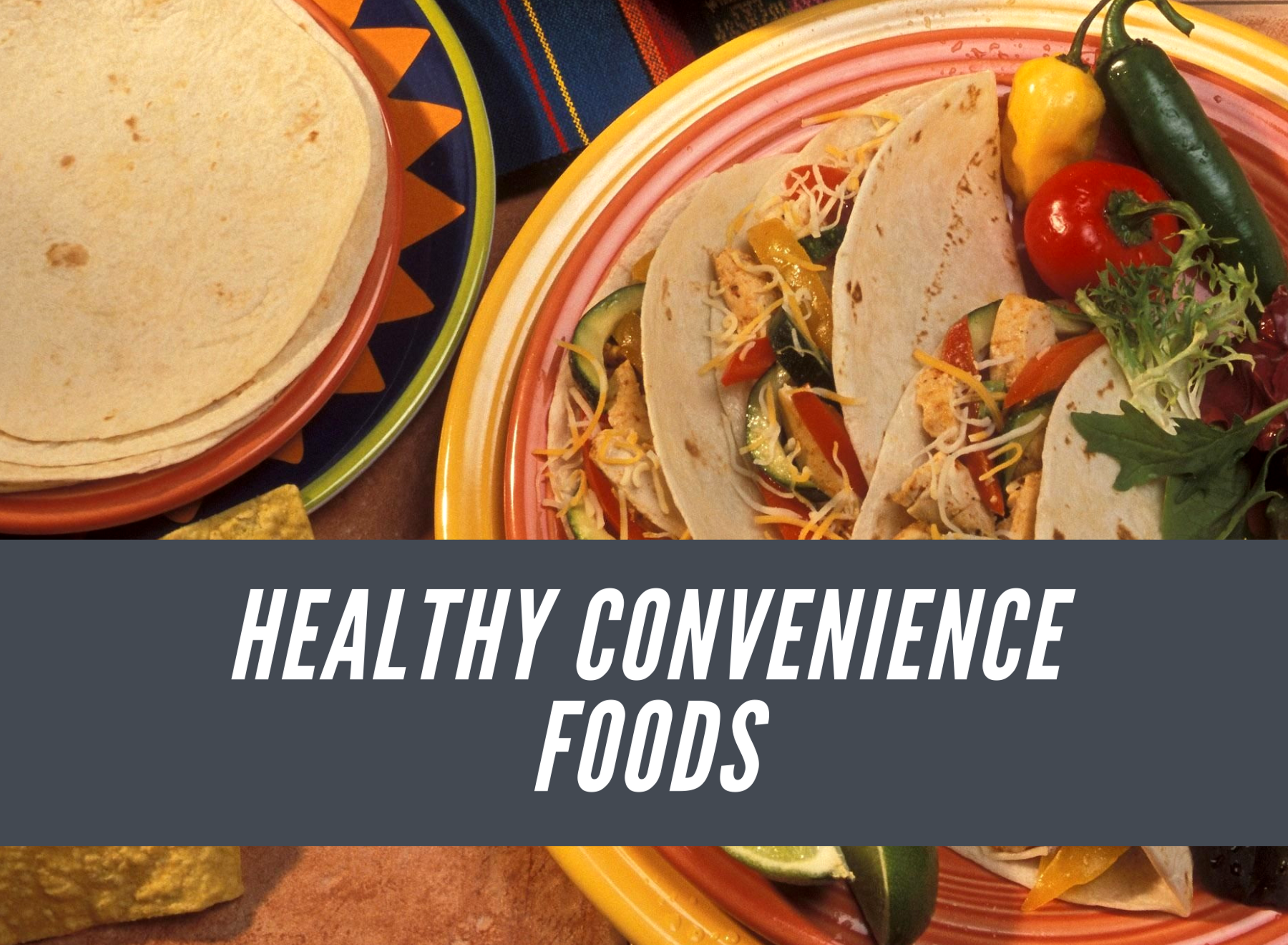
by Trish Adams | Jun 24, 2014 | Nutrition, Stress
It seems like each year moves quicker than the last. There is never enough time to get all the things done on our task list. Each day runs into the next, and if we aren’t careful, our nutrition takes a back seat to convenience. That’s where healthy convenience foods come in handy.
I experienced this firsthand over the past year when work stress was at an all-time high. I was mostly concerned with just getting enough sleep. My nutrition stayed intact by focusing on eating foods that didn’t require much time, effort or thought, but were still nutritionally balanced.
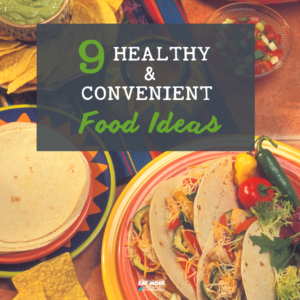 When you think of convenience food you may conjure up images of Hungry Man or fast food restaurants like McDonald’s. Thankfully, there are way better options available if you keep a go to list and put in just a smidgen of effort.
When you think of convenience food you may conjure up images of Hungry Man or fast food restaurants like McDonald’s. Thankfully, there are way better options available if you keep a go to list and put in just a smidgen of effort.
My definition of a healthy yet still convenient meal is one that requires minimal effort to prepare, can be assembled in 15 minutes or less and is nutritionally dense and balanced. Although it may require a little bit of energy to assemble, it won’t require any special cooking skills or even a measuring cup! If I can’t spare 15 minutes out of my day then I have to rethink what I’m doing.
All convenience foods aren’t created equal and some things to be on the lookout for are foods that are high in sodium, sugar, fat or all three! Many frozen foods that are fully prepared like Hungry Man or foods cooked in a sauce are often offenders. Assembling your own food will help you avoid the high sodium-sugar-fat trap.
Let’s get…assembling!
 A great place to start is with your protein. I like to think of protein as the super star of the meal and work everything else around it. Nowadays, there are so many pre-cooked protein options that you can really set up a great rotation. Rotisserie chicken , grilled chicken (refrigerated or frozen) or fish (fresh or canned i.e. tuna, sardines, wild salmon) are just a few options.
A great place to start is with your protein. I like to think of protein as the super star of the meal and work everything else around it. Nowadays, there are so many pre-cooked protein options that you can really set up a great rotation. Rotisserie chicken , grilled chicken (refrigerated or frozen) or fish (fresh or canned i.e. tuna, sardines, wild salmon) are just a few options.
Likewise, there are many pre-cooked carb options available – frozen, refrigerated or canned. A few to consider are quinoa, rice varieties including brown, white, jasmine and more, lentils, canned beans. With these options it’s just a matter of heat and serve.
When it comes to veggies, the options are seemingly endless. You can buy them fresh, frozen or canned. For even more convenience, buy them pre-washed, pre-sliced or pre-chopped. You can find them stand alone or as part of a medley. You can even find them in microwavable bags where you only need pop them directly in the microwave for 5-10 mins and then plate them. The point is, when it comes to veggies, skipping out on them for the sake of convenience is hogwash. Keeping dishes flavorful, however, is key, so consider picking up seasons such as garlic salt, lemon pepper or Cajun to keep your taste buds happy.
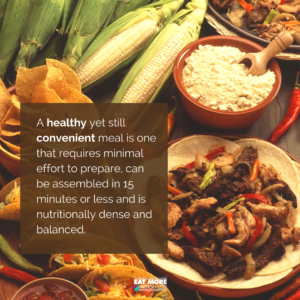 Of all the convenience foods, fats are the most readily available. Adding a tablespoon or two of your favorite oil to your foods or sauteing veggies in a pat of butter is a no-brainer. Same thing for avocado, just cut and scoop! Eating a fatty fish rich in Omega-3 like salmon will serve double duty, providing both protein and fat for your meal.
Of all the convenience foods, fats are the most readily available. Adding a tablespoon or two of your favorite oil to your foods or sauteing veggies in a pat of butter is a no-brainer. Same thing for avocado, just cut and scoop! Eating a fatty fish rich in Omega-3 like salmon will serve double duty, providing both protein and fat for your meal.
To keep things less stressful, be sure to keep some of these foods on hand to make answering the question of “What’s for dinner?” a breeze.
Putting it altogether
Now that you have a few ideas of some convenient staples, here are a few ideas on how to put together a meal.
- Rotisserie chicken, skinned & chopped + jasmine rice + broccoli slaw + dressing
- TJs Lightly seasoned chicken breast + lentils + asparagus
- Tuna + broccoli + avocado toss
- Broiled tilapia (10 min) + vegetable medley + low sodium butternut squash soup
- Broiled salmon (10 min) + mango salsa + green peas + brown rice
- Tacos – browned ground turkey (10 min) + salad + avocado
- Eggs/onion/mushroom/spinach scramble + Ezekiel bread + almond butter
- Rotisserie chicken, skinned & chopped + broccoli slaw + wrap + dressing
- Baby spinach + chopped grilled chicken + sliced peppers + quinoa + olive oil + balsamic vinegar
There are so many options that you can create with a few staple ingredients. Just mix things up or change out the seasonings. With all of the options available to you, it’s possible to have a new meal every day for a month if you wanted to.
You don’t have to sacrifice your nutrition for convenience and you don’t need to be a star cook. With slightly more effort than it takes to warm up a hungry man, you can have a meal that takes less time and is more nutritious! Many meals will make 2-4 servings, so you’ll only need to re-heat them the next day. One less meal to worry about!

 An approach often recommended and used by the EM2WL coaches is eating based on your body type. As with most things related to fitness, every body is unique and finding what works for you and your lifestyle takes some trial and observation. Two people with the same body type may have different diet histories, different external stressors, hormonal imbalances, etc. which may impact results even when eating the same diet. That being said, eating for your body type takes into account metabolic differences based on physical attributes and can guide you with your diet choices.
An approach often recommended and used by the EM2WL coaches is eating based on your body type. As with most things related to fitness, every body is unique and finding what works for you and your lifestyle takes some trial and observation. Two people with the same body type may have different diet histories, different external stressors, hormonal imbalances, etc. which may impact results even when eating the same diet. That being said, eating for your body type takes into account metabolic differences based on physical attributes and can guide you with your diet choices. pear shapes, gain weight easily and are often challenged when trying to lose weight. Endomorphs fair best with more fat and protein in their diet with carb intake kept at a moderate level and arranged around their activity.
pear shapes, gain weight easily and are often challenged when trying to lose weight. Endomorphs fair best with more fat and protein in their diet with carb intake kept at a moderate level and arranged around their activity. Undoubtedly many (primarily women) will try to fit into the endomorph category. Even classic ectomorphs will readily identify as an endomorph when trying to lose weight. However, I caution you NOT to immediately assume that your body type is endomorph simply because you are carrying “extra” body fat.
Undoubtedly many (primarily women) will try to fit into the endomorph category. Even classic ectomorphs will readily identify as an endomorph when trying to lose weight. However, I caution you NOT to immediately assume that your body type is endomorph simply because you are carrying “extra” body fat.











 It’s been said that success boils down to 80% nutrition, and 20% training. Other people will tell you that you “can’t out-train a bad diet.” It could be argued also that you can’t out-diet bad training, but you get the idea. Nutrition is a critical component, if not THE critical component in seeing the results that you want. If your nutrition is not on point, it is pretty much useless to add in supplements, metabolic conditioning, finishers, or the latest strength training plan that you found on the internet. Contrary to what you may have heard, eating less and moving more is not always the answer. Undereating can cause more harm than good long-term, resulting in metabolic problems that make it more difficult to lose weight. Eating enough of the right nutrients is a big piece of the puzzle. Balancing a sound nutrition plan with heavy resistance training is a surefire way to look and feel your best for years to come!
It’s been said that success boils down to 80% nutrition, and 20% training. Other people will tell you that you “can’t out-train a bad diet.” It could be argued also that you can’t out-diet bad training, but you get the idea. Nutrition is a critical component, if not THE critical component in seeing the results that you want. If your nutrition is not on point, it is pretty much useless to add in supplements, metabolic conditioning, finishers, or the latest strength training plan that you found on the internet. Contrary to what you may have heard, eating less and moving more is not always the answer. Undereating can cause more harm than good long-term, resulting in metabolic problems that make it more difficult to lose weight. Eating enough of the right nutrients is a big piece of the puzzle. Balancing a sound nutrition plan with heavy resistance training is a surefire way to look and feel your best for years to come! Devote one day to food prep. This doesn’t mean you need to spend all day in the kitchen, but do make up some lean protein sources and store them in a way that is convenient for you. Make up some rice, quinoa, or potatoes and chop your veggies and fruits for the week. This will seriously cut down on the amount of time you spend in the kitchen and if you work outside the home can be a huge time-saver when it comes time to pack your lunch. Think about using the grill for preparing your protein sources. You can generally get away with cooking up a lot of meat in a very short amount of time, with minimal clean up. Investing in a rice cooker or a good slow cooker might make these ideas easier as well! I prefer to do my food prep days on the days I do grocery shopping because it seems to make sense for me. I’m usually able to get quite a bit done in only an hour or two, and this saves me a ton of time in the kitchen throughout the week!
Devote one day to food prep. This doesn’t mean you need to spend all day in the kitchen, but do make up some lean protein sources and store them in a way that is convenient for you. Make up some rice, quinoa, or potatoes and chop your veggies and fruits for the week. This will seriously cut down on the amount of time you spend in the kitchen and if you work outside the home can be a huge time-saver when it comes time to pack your lunch. Think about using the grill for preparing your protein sources. You can generally get away with cooking up a lot of meat in a very short amount of time, with minimal clean up. Investing in a rice cooker or a good slow cooker might make these ideas easier as well! I prefer to do my food prep days on the days I do grocery shopping because it seems to make sense for me. I’m usually able to get quite a bit done in only an hour or two, and this saves me a ton of time in the kitchen throughout the week! Having people in your life who are willing to support your goals can make a huge difference! Enlisting the support of your spouse or significant other is often very beneficial. Even if they don’t have the same set of goals as you do, share what you are trying to accomplish and a brief description of your plan moving forward. Be clear about ways they can support you and examples of things that may be a hindrance to your fitness journey. They are likely to be your biggest cheerleader and encourager! Who knows, they may even decide it wouldn’t hurt them to make a few changes in their own life! Apart from your spouse, you may find there are others in your life that want to join with you on your fitness journey. Maybe there is someone at your workplace who could use a little encouragement and accountability as well. Take your headphones out occasionally while you are at the gym and get to know those who work out at the same time you do. Meet a friend for a weekly HIIT date in the park. Having a training partner to bounce ideas off of can be an invaluable resource, but isn’t always practical.
Having people in your life who are willing to support your goals can make a huge difference! Enlisting the support of your spouse or significant other is often very beneficial. Even if they don’t have the same set of goals as you do, share what you are trying to accomplish and a brief description of your plan moving forward. Be clear about ways they can support you and examples of things that may be a hindrance to your fitness journey. They are likely to be your biggest cheerleader and encourager! Who knows, they may even decide it wouldn’t hurt them to make a few changes in their own life! Apart from your spouse, you may find there are others in your life that want to join with you on your fitness journey. Maybe there is someone at your workplace who could use a little encouragement and accountability as well. Take your headphones out occasionally while you are at the gym and get to know those who work out at the same time you do. Meet a friend for a weekly HIIT date in the park. Having a training partner to bounce ideas off of can be an invaluable resource, but isn’t always practical. 






 When you think of convenience food you may conjure up images of Hungry Man or fast food restaurants like McDonald’s. Thankfully, there are way better options available if you keep a go to list and put in just a smidgen of effort.
When you think of convenience food you may conjure up images of Hungry Man or fast food restaurants like McDonald’s. Thankfully, there are way better options available if you keep a go to list and put in just a smidgen of effort. A great place to start is with your
A great place to start is with your  Of all the convenience foods, fats are the most readily available. Adding a tablespoon or two of your favorite oil to your foods or sauteing veggies in a pat of butter is a no-brainer. Same thing for avocado, just cut and scoop! Eating a fatty fish rich in Omega-3 like salmon will serve double duty, providing both protein and fat for your meal.
Of all the convenience foods, fats are the most readily available. Adding a tablespoon or two of your favorite oil to your foods or sauteing veggies in a pat of butter is a no-brainer. Same thing for avocado, just cut and scoop! Eating a fatty fish rich in Omega-3 like salmon will serve double duty, providing both protein and fat for your meal.
Recent Comments